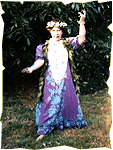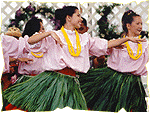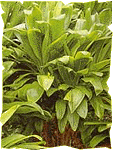 |
 |
 |
|
|||
|
Part 3: Wide-Eyed Slowness

Teresa: We are now fourteen miles from Kindy and Cheri's home, in a retired coast guard station now used for local traditional arts. Cheri studies hula here. Kindy and Cheri's 14 year-old godson, Josh, is with us, though he doesn't plan to dance tonight. He's at that self-conscious age, even though Kindy reminds him that hula is one of the oldest Hawaiian traditions. 
Teresa: Greetings and excitement fill this cinder-block building. Folks arrive from work at luxury hotels and small shops, anxious to learn the language of hula. They take off their shoes and change into loose-fitting clothes. The big orange sun, setting over the ocean, lights the room; later, as the gloaming deepens, battery-powered lamps come on. There is no electricity here. Class begins with a prayer-like chant from Raylene Lancaster, the hula kumu, or master. Teresa: Raylene, a gentle woman with a luxurious gray braid, sits cross-legged at the front, holding a huge gourd on her lap. She taps it, and it resonates with surprising force. The chatter in the room breaks off, and everyone focuses on Raylene. Hal: In an instant the dancers ignite in a flow of movement that starts with the hands and reverberates throughout the body. The room warms with concentration and the entranced energy from Raylene's beat. Teresa and I struggle to imitate those around us. This is supposed to be a beginners class, but we're the only ones who don't seem to know what we're doing.

Teresa: Words in the Hawaiian language have several layers of meaning. Hula adds its own layers with every movement and nuance of music.
Hal: We learn from Raylene that hula is more than dance, more than art. It is prayer. It is self-examination. She calls it 'living a life of hula.'
Teresa: Most of the people here come to several classes each week, thirsting for the knowledge and satisfaction that hula gives. So, yes, it is a beginners class but even the most rudimentary movements deepen in meaning with practice. A week ago, if someone would have told me that my big 6' 5" Buddha of a husband would be doing the hula, I would have laughed out loud. But he is so entranced by the dance and honestly, if I may say so, beautiful in it, that I know he's only half joking when he suggests we move here so we can study with Raylene. Teresa: The Pacific Ocean crashes against the beach of North Kohala on our last day on the Big Island. We've gotten up early to spend the morning with Cheri, Kindy's wife. Later today, Cheri will drive to Kona to pick up friends from the mainland, and she wants to make leis for them. 
Teresa: A cardinal sits high in a breadfruit tree and sings while we pick ti leaves in the back yard. These ti leaves are not the sort you steep in hot water and drink. Spelled "t-i" rather than "t-e-a," they are deep green and shiny, two or even three feet long, and they can be twisted into green ropes, a favorite lei for travelers, since ti leaf is said to ward off evil.
Teresa: We go into the house, where Cheri softens each leaf by quickly passing it over the burner on the gas stove.
Teresa: Ti leaves have a hundred uses. They are used to wrap around food before steaming in a traditional oven. They are Hawaiian paper plates; at a luau, you can pile your food on top of one. They have medicinal uses, and are surprisingly strong. Teresa: We've moved outside again, and are sitting on the deck, the whole vast panorama of the Pacific 500 feet below us. Cheri is showing me how to twist the ti leaves into a two-strand rope.
Hal: All week, we've watched a constant stream of tourists pull up to the dead-end in front of Cheri and Kindy's house, check out the view, and then turn around in their rental cars and head for the next destination. I realize how fortunate we are and how rare it is to be here. As we sit on the deck, I ask Kindy if he has any advice for tourists like us. He told me he figured most of us could benefit by slowing down and keeping our eyes open. Especially, he added, the eyes of the heart. Teresa: That's the irony of it. We came here to slow down, to veg out. But Kindy's talking about a different type of slowness, a wide-eyed slowness, a willingness to take everything in. Kindy learned it from his elders; Josh is learning it from him, and so are we. From the Open Road I'm Teresa Jordan with Hal Cannon, or as he's known here in Hawaii, Hale'boy Pukuni'ahi, for the Savvy Traveler.
For suggestions on Hawaiian Literature, be sure to visit: Native Books & Beautiful Things
|
 | American Public Media Home | Search | How to Listen ©2004 American Public Media | Terms of Use | Privacy Policy |
